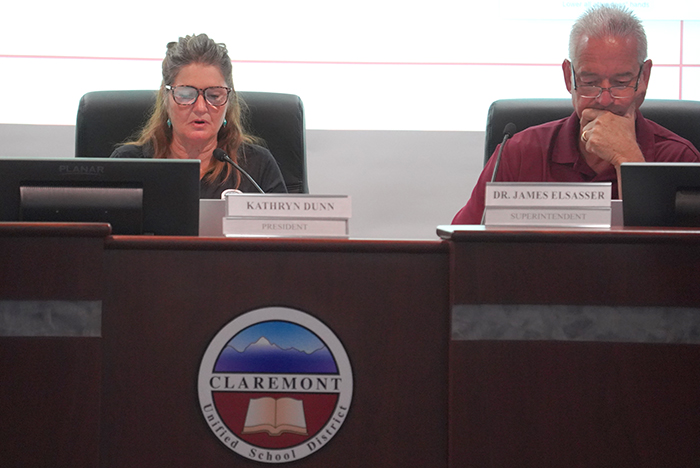CUSD projects $6 million deficit in 2025-26

(L-R) Claremont Unified School District Board of Education President Kathryn Dunn and Superintendent Jim Elsasser at the June 23 board meeting. Courier photo/Andrew Alonzo
by Andrew Alonzo | aalonzo@claremont-courier.com
Claremont Unified School District’s Board of Education marked its last meeting of the 2024-25 school year on June 23 with a 4-0 vote to approve its 2025-26 budget, which will see it operating at a near $6 million deficit.
The district projects $100,272,143 in revenues in 2025-26, and $106,263,389 in expenditures (which includes the first of three $1,191,818 interfund transfers across the next three school years). The negative balance will be made up by using funds from CUSD’s reserves, which currently stand at $17.3 million, according to CUSD’s budget report.
On the revenue side, $74,532,358 is projected to come in from the state in the form of local control funding formula money (which the state sends to school districts based on the total amount of pupils who attend their schools in any given year. That number was $74.8 million last year.), $12,628,112 from local revenues, $10,480,378 in other state funds, and $2,631,295 million in federal funds.
Expenditures are projected to include $41,950,112 for certificated employee salaries, $16,489,954 in classified employee salaries, $25,699,073 in employee benefits, $14,723,775 in services and operating expenses, $4,391,302 for books and supplies, $2,049,256 for “other outgoing,” $1,191,818 in the aforementioned interfund transfers, and $110,000 for capital outlay. Expenditures will be offset by a $341,901 influx of surplus “direct support/indirect costs” in each of the next three school years.
“The $341,901 is not a surplus or new money,” CUSD spokesperson Elaine Kong wrote in an email. “Each year we apply the state-approved indirect cost rate to our restricted grants, such as Title I, Special Education, and other categorical programs. That rate transfers a small percentage of those grant dollars to the unrestricted General Fund to reimburse district-wide services like payroll, HR, IT, and purchasing that support the programs. Because that reimbursement is booked as revenue to the General Fund, it appears in the Direct Support/Indirect Costs line as a negative expenditure, which lowers the gross expenditure total from roughly $106.6 million to $106.2 million. It is an internal cost-allocation entry required by California school accounting rules, not an available surplus. The $341,901 represents the combined reimbursement for the 2025-26, 2026-27, and 2027-28 fiscal years.”
The exact deficit amount for 2025-26 is $5,991,246.
Current financial projections do not factor in ongoing salary negotiations with its unions, or a state proposed discretionary block grant, CUSD Assistant Superintendent of Business Services Desiree Reyes said.
The district has also projected deficits of $3.3 million for 2026-27 and $3 million 2027-28, both of which are to be offset with funds from CUSD reserves, which are projected to be depleted to about $5 million by the end of the 2027-28 school year.
During the board’s June 19 public hearing, Reyes cited the high cost of living in California, falling enrollment, sagging daily attendance, and lower birth rates as factors contributing to CUSD’s budget deficits.
Like most surrounding districts, CUSD has seen its enrollment decline over the last few years. It expects to lose about 150 students over the next three school years, according to Reyes.
According to the state’s school dashboard, CUSD had 6,261 students in 2024. According to the district’s local control and accountability plan, which was also approved unanimously on June 23, CUSD’s attendance rate, the overall percentage of enrolled students who attend school over a given year, was 94.93% in 2024-25, up slightly from last year’s 94.34%. Reyes said the district projects its attendance rate to rise to 95.5% for each of the next three school years.
State allocated local control funding formula monies account for about 75% of CUSD’s revenue.
“When compared to the [cost of living adjustment], CUSD’s [local control funding formula]-based funding increase is lower due to the declining enrollment and declining attendance rates,” Reyes said. “In other words, if enrollment and attendance had not declined over the last few years, our LCFF-based revenue would have increased by 2.30 percent — the [cost of living adjustment]. Instead, compared to our 24-25 revenue, the LCFF based revenue is projected to decrease by .76 percent in 25-26.”
The district continues to watch for several factors when crafting its budget estimates, including “the uncertain future of the economy, the challenges of declining enrollment and lower attendance rates and costs associated with annual collective bargaining,” Reyes said.
Elaine Kong, CUSD’s director of communications, was asked if CUSD was at risk of a financial crisis.
“Claremont Unified has consistently remained solvent and has never faced a risk of insolvency,” Kong wrote in an email. “The district has always met its financial obligations, including payroll. Our budgets undergo regular review and oversight by the Los Angeles County Office of Education (LACOE), and we continue to receive positive certifications that affirm our ability to meet all current and future financial commitments.
“CUSD remains committed to long-term fiscal responsibility,” Kong added. “The district monitors funding projections closely and strategically plans through multi-year forecasting. Like many districts across the state, we regularly evaluate all expenditures to ensure we meet student needs while maintaining financial stability.”
Other CUSD news
Also at its June 23 meeting, the board approved, again by unanimous vote, revisions to the 2024-27 local control and accountability plan, which outlines how the district plans on spending its projected $74.5 million in local control funding formula monies for the coming school year.
The board also approved a report on CUSD’s goals related to California School Dashboard data on school conditions and climate, implementation of state academic standards, parent engagement, and access to a broad course of study. Director of Educational Services Natalie Taylor Barbiera said CUSD had met the requirements set out in each goal.
Board Clerk Alex McDonald was absent from the June 19 public hearing and June 23 board meeting.
The next school board meeting is 6:30 p.m. Thursday, August 7 at 170 San Jose Ave., Claremont.










0 Comments